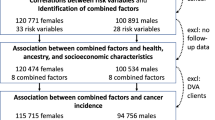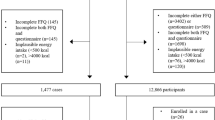Abstract
Objective:
To identify different dietary patterns in Norway using a combination of cluster and factor analysis.
Design:
Cross-sectional study.
Setting:
Nation-wide, population-based study.
Subjects:
The Norwegian EPIC cohort is a subcohort of the Norwegian Women and Cancer study (NOWAC), and consist 37.226 women aged 41–56 y who answered a food frequency questionnaire (FFQ) in 1998.
Interventions:
The associations among 50 food variables were first investigated by using principal component analysis. Five important factors were found. The five principal components were then used as input in the cluster analysis. Different socioeconomic and lifestyle variables were examined.
Results:
Six clusters of dietary patterns were found, and were labelled accordingly: ‘traditional fish eaters’, ‘healthy eaters’, ‘average, less fish, less healthy’, ‘Western’, ‘traditional bread eaters’, and ‘alcohol users’. The traditional fish eaters and the traditional bread eaters were both highly represented in the north and west of Norway and were more likely to be present among persons with lower income and lower education. The healthy and the alcohol drinkers were found mostly in the south and east and were more likely to have higher income. Persons in the alcohol group were more likely to be current smokers. The western group had the highest percentage of three or more persons in the household and the shortest time since last birth, indicating that families with children dominate this group.
Conclusion:
Our data indicate six different dietary patterns in Norway, each with different socio-demographic and lifestyle characteristics.
Sponsorship:
The Norwegian Cancer Society (E 04038/006).
This is a preview of subscription content, access via your institution
Access options
Subscribe to this journal
Receive 12 print issues and online access
$259.00 per year
only $21.58 per issue
Buy this article
- Purchase on Springer Link
- Instant access to full article PDF
Prices may be subject to local taxes which are calculated during checkout
Similar content being viewed by others
References
Amilien V, Bjørkum E, Bugge A, Dulsrud A, Døving R, Fagerli R, Jacobsen E, Kjærnes U, Lavik R, Stø E, Torjusen H & Vittersø G (2000): Om matkultur. National Institute for Consumer Research (SIFO). 19-2000 (report) (in Norwegian).
Blaker B, Aarsland M & Landsforeningen for kosthold og helse (1989): Mål og vekt for matvarer. Oslo: Landsforeningen for kosthold & helse (in Norwegian).
Brustad M, Braaten T & Lund E (2004): Predictors for cod-liver oil supplement use—the Norwegian Women and Cancer Study. Eur. J. Clin. Nutr. 58, 128–136.
Chen HL, Ward MH, Graubard BI, Heineman EF, Markin RM, Potischman NA, Russell RB, Weisenburger DD & Tucker KL (2002): Dietary patterns and adenocarcinoma of the esophagus and distal stomach. Am. J. Clin. Nutr. 75, 137–144.
Everitt BS, Leese M & Landau S (2001): Cluster Analysis, 4th Edition. London: Arnold.
Ferrari P, Slimani N, Ciampi A, Trichopoulou A, Naska A, Lauria C, Veglia F, Bueno-de-Mesquita HB, Ocké MC, Brustad M, Braaten T, José Tormo M, Amiano P, Mattisson I, Johansson G, Welch A, Davey G, Overvad K, Tjønneland A, Clavel-Chapelon F, Thiebaut A, Linseisen J, Boeing H, Hemon B & Riboli E (2002): Evaluation of under- and overreporting of energy intake in 24-hour diet recalls in the European Prospective Investigation into Cancer and Nutrition (EPIC). Public Health Nutr. 5, 1329–1345.
Fraser GE, Welch A, Luben R, Bingham SA & Day NE (2000): The effect of age, sex, and education on food consumption of a middle-aged English cohort—EPIC in East Anglia. Prevent. Med. 30, 26–34.
Fung T, Hu FB, Fuchs C, Giovannucci E, Hunter DJ, Stampfer MJ, Colditz GA & Willett WC (2003): Major dietary patterns and the risk of colorectal cancer in women. Arch. Intern. Med. 163, 309–314.
Fung TT, Willett WC, Stampfer MJ, Manson JE & Hu FB (2001): Dietary patterns and the risk of coronary heart disease in women. Arch. Intern. Med. 161, 1857–1862.
Greenwood DC, Cade JE, Draper A, Barrett JH, Calvert C & Greenhalgh A (2000): Seven unique food consumption patterns identified among women in the UK Women's Cohort Study. Eur. J. Clin. Nutr. 54, 314–320.
Hair JF (1995): Multivariate Data Analysis with Readings, 4th Edition. New York: Prentice-Hall.
Handa K & Kreiger N (2002): Diet patterns and the risk of renal cell carcinoma. Public Health Nutr. 5, 757–767.
Hjartåker A & Lund E (1998): Relationship between dietary habits, age, lifestyle, and socio-economic status among adult Norwegian women. The Norwegian Women and Cancer Study. Eur. J. Clin. Nutr. 52, 565–572.
Hoffmann K, Schulze M, Boeing H & Altenburg H (2000): Dietary patterns: report of an international workshop. Public Health Nutr. 5, 89–90.
Hu FB, Bronner L, Willett WC, Stampfer MJ, Rexrode KM, Albert CM, Hunter D & Manson JE (2002): Fish and omega-3 fatty acid intake and risk of coronary heart disease in women. JAMA 287, 1815–1821.
Hu FB, Rimm E, Smith-Warner SA, Feskanich D, Stampfer MJ, Ascherio A, Sampson L & Willett WC (1999): Reproducibility and validity of dietary patterns assessed with a food-frequency questionnaire. Am. J. Clin. Nutr. 69, 243–249.
Jacobsen BK & Thelle DS (1987): The Tromso Heart Study: the relationship between food habits and the body mass index. J.Chronic.Dis. 40, 795–800.
Jacques PF & Tucker KL (2001): Are dietary patterns useful for understanding the role of diet in chronic disease? Am. J. Clin. Nutr. 73, 1–2.
Johansson L, Solvoll K, Bjorneboe GE & Drevon CA (1997): Dietary habits among Norwegian men and women. Scand. J. Nutr. 41, 63–70.
Johansson L, Thelle DS, Solvoll K, Bjorneboe GE & Drevon CA (1999): Healthy dietary habits in relation to social determinants and lifestyle factors. Br. J. Nutr. 81, 211–220.
Kjærnes U, Ekström MP, Gronow J, Holm L, Mäkelä J, Jääskeläinen A, Fürst EL & Berg L (2001): Eating Patterns. A day in the Lives of Nordic People. National Institute for Consumer Research (SIFO), 7-2001 (report).
Landbruksdepartementet & Informasjonsenheten (1997): Norsk mat- og ernæringspolitikk. Myndighetenes rolle. In Trygg mat til forbrukarane, stortingsmelding om matkvalitet og forbrukartryggleik chapter 5, ed. Informasjonsenheten. Oslo: Landbruksdepartementet, Informasjonseininga (in Norwegian).
Lund E, Kumle M, Braaten T, Hjartaker A, Bakken K, Eggen E & Gram TI (2003): External validity in a population-based national prospective study—the Norwegian Women and Cancer Study (NOWAC). Cancer Causes Control 14, 1001–1008.
Markaki I, Linos D & Linos A (2003): The influence of dietary patterns on the development of thyroid cancer. Eur J Cancer. 39, 1912–1919.
Millen BE, Quatromoni PA, Gagnon DR, Cupples LA, Franz MM & DAgostino RB (1996): Dietary patterns of men and women suggest targets for health promotion: The Framingham Nutrition Studies. Am J Health Promotion 11, 42–52.
Millen BE, Quatromoni PA, Nam BH, O'Horo CE, Polak JF & D'Agostino RB (2002): Dietary patterns and the odds of carotid atherosclerosis in women: The Framingham nutrition studies. Prevent. Med. 35, 540–547.
Milligan GW & Cooper MC (1985): An examination of procedures for determining the number of clusters in a data set. Psychometrika 50, 159–179.
Mishra G, Ball K, Arbuckle J & Crawford D (2002): Dietary patterns of Australian adults and their association with socioeconomic status: results from the 1995 National Nutrition Survey. Eur. J. Clin. Nutr. 56, 687–693.
Newby P, Muller D, Hallfrisch J, Qiao N, Andres R & Tucker KL (2003): Dietary patterns and changes in body mass index and waist circumference in adults. Am. J. Clin. Nutr. 77, 1417–1425.
Oomen CM, Feskens EJ, Rasanen L, Fidanza F, Nissinen AM, Menotti A, Kok FJ & Kromhout D (2000): Fish consumption and coronary heart disease mortality in Finland, Italy, and The Netherlands. Am. J. Epidemiol. 151, 999–1006.
Pryer JA, Nichols R, Elliott P, Thakrar B, Brunner E & Marmot M (2001): Dietary patterns among a national random sample of British adults. J. Epidemiol. Commun. Health 55, 29–37.
Pryer JA, Vrijheid M, Nichols R, Kiggins M & Elliott P (1997): Who are the ‘low energy reporters’ in the dietary and nutritional survey of British adults? Int. J. Epidemiol. 26, 146–154.
Quatromoni PA, Copenhafer DL, Demissie S, D'Agostino RB, O'Horo CE, Nam BH & Millen BE (2002): The internal validity of a dietary pattern analysis: The Framingham nutrition studies. J. Epidemiol. Commun. Health 56, 381–388.
Riboli E, Hunt KJ, Slimani N, Ferrari P, Norat T, Fahey M, Charrondiere UR, Hemon B, Casagrande C, Vignat J, Overvad K, Tjonneland A, Clavel-Chapelon F, Thiebaut A, Wahrendorf J, Boeing H, Trichopoulos D, Trichopoulou A, Vineis P, Palli D, Bueno-De-Mesquita HB, Peeters PH, Lund E, Engeset D, Gonzalez CA, Barricarte A, Berglund G, Hallmans G, Day NE, Key TJ, Kaaks R & Saracci R (2002): European Prospective Investigation into Cancer and Nutrition (EPIC): study populations and data collection. Public Health Nutr. 5, 1113–1124.
Rimestad AH, Statens næringsmiddeltilsyn, Statens råd for ernæring og fysisk aktivitet & Universitetet i Oslo & Institutt for ernæringsforskning (2001): Matvaretabellen, 2nd Edition. Oslo: Gyldendal undervisning.
Sanchez-Villegas A, Delgado-Rodriguez M, Martinez-Gonzalez MA & Irala-Estevez J (2003): Gender, age, socio-demographic and lifestyle factors associated with major dietary patterns in the Spanish Project SUN (Seguimiento Universidad de Navarra). Eur. J. Clin. Nutr. 57, 285–292.
Schulze MB, Hoffmann K, Kroke A & Boeing H (2003): An approach to construct simplified measures of dietary patterns from exploratory factor analysis. Br. J. Nutr. 89, 409–418.
Slattery ML, Boucher KM, Caan BJ, Potter JD & Ma KN (1998): Eating patterns and risk of colon cancer. Am. J. Epidemiol. 148, 4–16.
Spencer EA, Appleby PN, Davey GK & Key TJ (2002): Validity of self-reported height and weight in 4808 EPIC-Oxford participants. Public Health Nutr. 5, 561–565.
Terry P, Hu FB, Hansen H & Wolk A (2001): Prospective study of major dietary patterns and colorectal cancer risk in women. Am. J. Epidemiol. 154, 1143–1149.
Tucker KL, Dallal GE & Rush D (1992): Dietary patterns of elderly Boston-area residents defined by cluster-analysis. J. Am. Dietetic Assoc. 92, 1487–1491.
van Dam RM, Grievink L, Ocke MC & Feskens EJM (2003): Patterns of food consumption and risk factors for cardiovascular disease in the general Dutch population. Am. J. Clin. Nutr. 77, 1156–1163.
Wirfalt AKE & Jeffery RW (1997): Using cluster analysis to examine dietary patterns: Nutrient intakes, gender, and weight status differ across food pattern clusters. J. Am. Dietetic Assoc. 97, 272–279.
Wirfalt E, Hedblad B, Gullberg B, Mattisson I, Andren C, Rosander U, Janzon L & Berglund G (2001): Food patterns and components of the metabolic syndrome in men and women: a cross-sectional study within the Malmo diet and cancer cohort. Am. J. Epidemiol. 154, 1150–1159.
Author information
Authors and Affiliations
Corresponding author
Additional information
Guarantor: D Engeset.
Contributors: DE wrote the paper and contributed to the statistical analysis. EA performed the statistical analysis and contributed to the writing of the paper. AC contributed to the writing of the paper and to the statistical analysis. EL was the principal investigator.
Supplementary Information accompanies the Paper on Euroepan Journal of Clinical Nutrition Website (http://www.nature.com/ejcn).
Supplementary information
Rights and permissions
About this article
Cite this article
Engeset, D., Alsaker, E., Ciampi, A. et al. Dietary patterns and lifestyle factors in the Norwegian EPIC cohort: The Norwegian Women and Cancer (NOWAC) study. Eur J Clin Nutr 59, 675–684 (2005). https://doi.org/10.1038/sj.ejcn.1602129
Received:
Revised:
Accepted:
Published:
Issue Date:
DOI: https://doi.org/10.1038/sj.ejcn.1602129
Keywords
This article is cited by
-
Identifying dietary patterns across age, educational level and physical activity level in a cross-sectional study: the Tromsø Study 2015 - 2016
BMC Nutrition (2022)
-
Non-linear associations between healthy Nordic foods and all-cause mortality in the NOWAC study: a prospective study
BMC Public Health (2022)
-
Association between dietary patterns and prediabetes, undetected diabetes or clinically diagnosed diabetes: results from the KORA FF4 study
European Journal of Nutrition (2021)
-
Plasma linoleic acid levels and cardiovascular risk factors: results from the Norwegian ACE 1950 Study
European Journal of Clinical Nutrition (2020)
-
Dietary patterns of adults and their associations with Sami ethnicity, sociodemographic factors, and lifestyle factors in a rural multiethnic population of northern Norway - the SAMINOR 2 clinical survey
BMC Public Health (2019)



